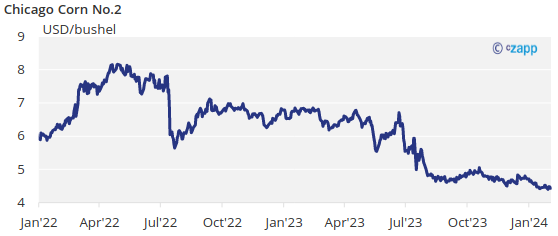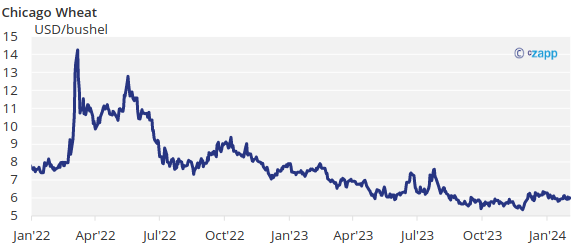Insight Focus
- All grains markets globally are well supplied.
- Mild weather conditions across the Americas loSource: European Commissionwer production risk.
- The USDA should revise corn production estimates upwards in Thursday’s WASDE report.
All grains were down in all geographies after a volatile week in Chicago. There was a strong negative start of the week followed by a rally on Tuesday that recovered all the Monday losses, but the second half of the week was negative. The COT in US corn, wheat and soybean continues to show a sizable net short, which is causing the volatility we are seeing as it leaves the market vulnerable for short covering rallies.
Americas Corn Conditions Improve
As of last Tuesday, a total of 17,700 lots of fresh spec shorts were added to US corn. The gross short now represents 33% of open interest – a historic high. The spec gross short in wheat is also sizable at 35.4% and in soybeans it is a bit smaller at 26.7%.

On the fundamental side, the European Commission left its corn production forecast unchanged at 61.7 million tonnes.

Source: European Commission
Rains continue in Brazil. While it may delay harvesting of soybeans, thereby having a knock-on effect on the planting of the second corn crop, it has improved soil moisture. Despite the potential delay, Safrinha planting is well ahead of last year so a potential slower planting pace should pose no risks to production forecasts.
Safrinha planting is 10.3% complete compared with 3.9% last year. The summer corn crop in Brazil is now 10.4% harvested versus 7.8% last year.
Argentina is also receiving rains that have improved soil moisture, which will benefit corn yields. Planting is now virtually finished at 98.4% planted, slightly ahead of the 97.2% recorded at the same time last year.
The USDA’s local office in Argentina increased its production forecast to 57 million tonnes – higher than January’s WASDE projections of 55 million tonnes and closer to the levels projected by BAGE. It is largely expected that the USDA will revise its WASDE estimates upwards to reflect this in the February report expected on Thursday.

Wheat Holds Steady
US wheat also started the week negative due to export inspection data released last Monday. Tender activity appeared following the dip and the market rallied back, erasing Monday losses.
The USDA local office in Argentina increased its production forecast to 15.4 million tonnes — slightly above the 15 million tonnes projected in the January WASDE report.
In a surprise move, the European Commission increased its wheat production forecast. However, the upward revision was just 167,000 tonnes higher to 126.9 million tonnes.

Source: European Commission
The US had dryer and warmer weather than usual, which is leading to snow melting in the growing areas, which benefits soil moisture. Conditions are expected to remain moist and rainy during the week. Europe is expected to experience milder weather, with rains arriving across most of the growing areas.
The big picture is that the market is well supplied with only world wheat stocks lower year on year by some 11 million tonnes. However, this is more than offset by 25 million tonnes of higher world corn stocks and 13 million tonnes of higher soybean stocks. Prices are vulnerable to spikes due to short covering rallies given the sizable short position of spec funds. Overall the risk should continue to be to the downside.

There is no change to our Chicago corn forecast for the 2023/24 (September/August) crop to average in a range of USD 4.15/bushel to USD 4.40/bushel. The average price since September 1 is running at USD 4.70/bushel.














